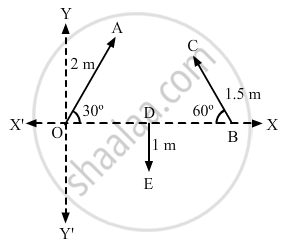Advertisements
Advertisements
प्रश्न
Let \[\vec{a} = 4 \vec{i} + 3 \vec{j} \text { and } \vec{b} = 3 \vec{i} + 4 \vec{j}\]. Find the magnitudes of (a) \[\vec{a}\] , (b) \[\vec{b}\] ,(c) \[\vec{a} + \vec{b} \text { and }\] (d) \[\vec{a} - \vec{b}\].
उत्तर
Given: \[\vec{a} = 4 \vec{i} + 3 \vec{j} \text { and } \vec{b} = 3 \vec{i} + 4 \vec{j}\]
(a) Magnitude of \[\vec{a}\] is given by \[\left| \vec{a} \right| = \sqrt{4^2 + 3^2} = \sqrt{16 + 9} = 5\]
Magnitude of \[\vec{b}\] is given by \[\left| \vec{b} \right| = \sqrt{3^2 + 4^2} = \sqrt{9 + 16} = 5\]
(c) \[\vec{a} + \vec{b} = (4 \hat {i} + 3 \hat {j} ) + (3 \hat { i} + 4 \hat { j} ) = (7 \hat { i} + 7 \hat {j} )\]
∴ Magnitude of vector \[\vec{a} + \vec{b}\] is given by \[\left| \vec{a} + \vec{b} \right| = \sqrt{49 + 49} = \sqrt{98} = 7\sqrt{2}\]
(d) \[\vec{a} - \vec{b} = \left( 4 \vec{i} + 3 \vec{j} \right) - \left( 3 \vec{i} + 4 \vec{j} \right) = \vec{i} - \vec{j}\]
∴ Magnitude of vector \[\vec{a} - \vec{b}\] is given by \[\left| \vec{a} - \vec{b} \right| = \sqrt{\left( 1 \right)^2 + \left( - 1 \right)^2} = \sqrt{2}\]
APPEARS IN
संबंधित प्रश्न
“Every great physical theory starts as a heresy and ends as a dogma”. Give some examples from the history of science of the validity of this incisive remark
What are the dimensions of the ratio of the volume of a cube of edge a to the volume of a sphere of radius a?
\[\int\frac{dx}{\sqrt{2ax - x^2}} = a^n \sin^{- 1} \left[ \frac{x}{a} - 1 \right]\]
The value of n is
The dimensions ML−1 T−2 may correspond to
Choose the correct statements(s):
(a) All quantities may be represented dimensionally in terms of the base quantities.
(b) A base quantity cannot be represented dimensionally in terms of the rest of the base quantities.
(c) The dimensions of a base quantity in other base quantities is always zero.
(d) The dimension of a derived quantity is never zero in any base quantity.
Find the dimensions of linear momentum .
Find the dimensions of magnetic field B.
The relevant equation are \[F = qE, F = qvB, \text{ and }B = \frac{\mu_0 I}{2 \pi a};\]
where F is force, q is charge, v is speed, I is current, and a is distance.
Find the dimensions of magnetic permeability \[\mu_0\]
The relevant equation are \[F = qE, F = qvB, \text{ and }B = \frac{\mu_0 I}{2 \pi a};\]
where F is force, q is charge, v is speed, I is current, and a is distance.
Find the dimensions of the specific heat capacity c.
(a) the specific heat capacity c,
(b) the coefficient of linear expansion α and
(c) the gas constant R.
Some of the equations involving these quantities are \[Q = mc\left( T_2 - T_1 \right), l_t = l_0 \left[ 1 + \alpha\left( T_2 - T_1 \right) \right]\] and PV = nRT.
Theory of relativity reveals that mass can be converted into energy. The energy E so obtained is proportional to certain powers of mass m and the speed c of light. Guess a relation among the quantities using the method of dimensions.
Can you add two vectors representing physical quantities having different dimensions? Can you multiply two vectors representing physical quantities having different dimensions?
Let ε1 and ε2 be the angles made by \[\vec{A}\] and -\[\vec{A}\] with the positive X-axis. Show that tan ε1 = tan ε2. Thus, giving tan ε does not uniquely determine the direction of \[\vec{A}\].
A vector is not changed if
The component of a vector is
The radius of a circle is stated as 2.12 cm. Its area should be written as
Refer to figure (2 − E1). Find (a) the magnitude, (b) x and y component and (c) the angle with the X-axis of the resultant of \[\overrightarrow{OA}, \overrightarrow{BC} \text { and } \overrightarrow{DE}\].

Suppose \[\vec{a}\] is a vector of magnitude 4.5 units due north. What is the vector (a) \[3 \vec{a}\], (b) \[- 4 \vec{a}\] ?
Two vectors have magnitudes 2 m and 3m. The angle between them is 60°. Find (a) the scalar product of the two vectors, (b) the magnitude of their vector product.
Jupiter is at a distance of 824.7 million km from the Earth. Its angular diameter is measured to be 35.72˝. Calculate the diameter of Jupiter.
High speed moving particles are studied under
